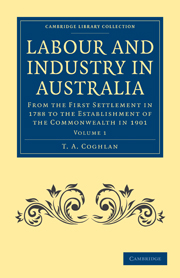 Labour and Industry in Australia
Labour and Industry in Australia Book contents
- Frontmatter
- PREFACE
- Contents
- PART I FROM THE FOUNDATION OF SETTLEMENT TO THE CROSSING OF THE MOUNTAINS
- I INTRODUCTION TO THE FIRST PERIOD
- II THE ASSIGNMENT SYSTEM
- III MUSTERS
- IV WAGES AND WORKING HOURS
- V THE CURRENCY
- VI LAND POLICY
- VII THE GENESIS OF THE WOOL INDUSTRY IN AUSTRALIA
- VIII THE INDUSTRIES OF THE PERIOD
- IX TRADE AND PRICES
- PART II FROM THE CROSSING OF THE MOUNTAINS TO THE ABOLITION OF THE ASSIGNMENT SYSTEM
- PART III FROM THE ABOLITION OF THE ASSIGNMENT SYSTEM TO THE DISCOVERY OF GOLD
- PART IV FROM THE DISCOVERY OF GOLD TO THE INTRODUCTION OF FREE SELECTION OF LAND BEFORE SURVEY
VIII - THE INDUSTRIES OF THE PERIOD
Published online by Cambridge University Press: 05 August 2011
- Frontmatter
- PREFACE
- Contents
- PART I FROM THE FOUNDATION OF SETTLEMENT TO THE CROSSING OF THE MOUNTAINS
- I INTRODUCTION TO THE FIRST PERIOD
- II THE ASSIGNMENT SYSTEM
- III MUSTERS
- IV WAGES AND WORKING HOURS
- V THE CURRENCY
- VI LAND POLICY
- VII THE GENESIS OF THE WOOL INDUSTRY IN AUSTRALIA
- VIII THE INDUSTRIES OF THE PERIOD
- IX TRADE AND PRICES
- PART II FROM THE CROSSING OF THE MOUNTAINS TO THE ABOLITION OF THE ASSIGNMENT SYSTEM
- PART III FROM THE ABOLITION OF THE ASSIGNMENT SYSTEM TO THE DISCOVERY OF GOLD
- PART IV FROM THE DISCOVERY OF GOLD TO THE INTRODUCTION OF FREE SELECTION OF LAND BEFORE SURVEY
Summary
AGRICULTURE
Agriculture was naturally the industry to which the English authorities and the Governors first turned their attention. To the former, agricultural development seemed to mean some relief of the heavy financial burden which the support of so distant a dependency entailed upon England, and to the latter the secure food supply which the colony so badly needed. The country was, on the whole, densely wooded; much of it was rocky, and good land was found only in patches. Nevertheless, immediately upon his arrival, Phillip set about clearing land for cultivation, and within six months of his debarkation he was able to report that he had ten acres of land in wheat and barley for the public use. Very little of the seed planted germinated, the bulk of it having been overheated on the voyage, while some had been attacked by the weevil, and thus the first effort at farming proved almost a complete failure. To add to his troubles, Phillip had but one man with any special knowledge of agriculture. On the advice of this man, the Government farm was transferred to Rose Hill, near Parramatta, where the land was much more fertile than at Sydney, and in December 1789 the first crops were gathered in Australia, comprising about 200 bushels of wheat and 60 of barley, with a small quantity of flax, Indian corn, and oats. The grain was found to be of “exceeding good” quality, and great hopes were entertained as to the future.
- Type
- Chapter
- Information
- Labour and Industry in AustraliaFrom the First Settlement in 1788 to the Establishment of the Commonwealth in 1901, pp. 114 - 131Publisher: Cambridge University PressPrint publication year: 2011First published in: 1918


